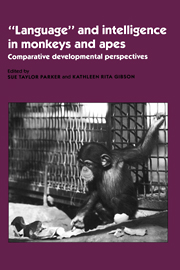Book contents
- Frontmatter
- Contents
- List of contributors
- Foreword
- Preface
- Acknowledgments
- Part I Theoretical frameworks for comparative developmental studies
- Part II Comparative developmental perspectives on cebus intelligence
- Part III Questions regarding imitation, “language,” and cultural transmission in apes and monkeys
- Part IV Developmental perspectives on social intelligence and communication in great apes
- Part V Development of numerical and classificatory abilities in chimpanzees and other vertebrates
- 16 The development of numerical skills in the chimpanzee (Pan troglodytes)
- 17 Spontaneous sorting in human and chimpanzee
- 18 Conceptual abilities of some nonprimate species, with an emphasis on an African Grey parrot
- Part VI Comparative developmental perspectives on ape “language”
- Index
17 - Spontaneous sorting in human and chimpanzee
Published online by Cambridge University Press: 11 May 2010
- Frontmatter
- Contents
- List of contributors
- Foreword
- Preface
- Acknowledgments
- Part I Theoretical frameworks for comparative developmental studies
- Part II Comparative developmental perspectives on cebus intelligence
- Part III Questions regarding imitation, “language,” and cultural transmission in apes and monkeys
- Part IV Developmental perspectives on social intelligence and communication in great apes
- Part V Development of numerical and classificatory abilities in chimpanzees and other vertebrates
- 16 The development of numerical skills in the chimpanzee (Pan troglodytes)
- 17 Spontaneous sorting in human and chimpanzee
- 18 Conceptual abilities of some nonprimate species, with an emphasis on an African Grey parrot
- Part VI Comparative developmental perspectives on ape “language”
- Index
Summary
Introduction
Spontaneous sorting of objects was investigated in human and chimpanzee subjects. Recent advances in the study of animal cognition have revealed that some components of human cognitive abilities are shared by nonhuman primates, especially the great apes. Many studies have shown that the great apes (chimpanzees, pygmy chimpanzees, gorillas, and orangutans) are capable, to some extent, of both producing and comprehending “words” in natural and artificial language systems (Asano, Kojima, Matsuzawa, Kubota, & Murofushi, 1982; Gardner & Gardner, 1969; Patterson, 1978; Premack, 1971; Rumbaugh, 1977; Terrace, 1979). Apes can place one thing in symbolic correspondence to another. They can correlate one thing not only with another “thing” but also in terms of “color” (Matsuzawa, 1985a), “number” (Matsuzawa, Asano, Kubota, & Murofushi, 1986), and other attributes. However, the limits of apes' ability to acquire such a system is controversial. Can they (Terrace, 1979) organize the “words” into a “sentence”? The question seems to be too vague to be answered, because the terms themselves cannot be easily defined. The fundamental question is how the apes classify and organize the world. The application of cognitive skills to hierarchical organization is a main concern of this study.
In a recent study of languagelike skills, a chimpanzee named Ai showed spontaneous organization of her acquired “words” (Matsuzawa, 1985b). The chimpanzee was required to name the number, color, and object for 300 types of samples by pressing the corresponding “word” keys (Figure 17.1).
- Type
- Chapter
- Information
- 'Language' and Intelligence in Monkeys and ApesComparative Developmental Perspectives, pp. 451 - 468Publisher: Cambridge University PressPrint publication year: 1990
- 9
- Cited by



